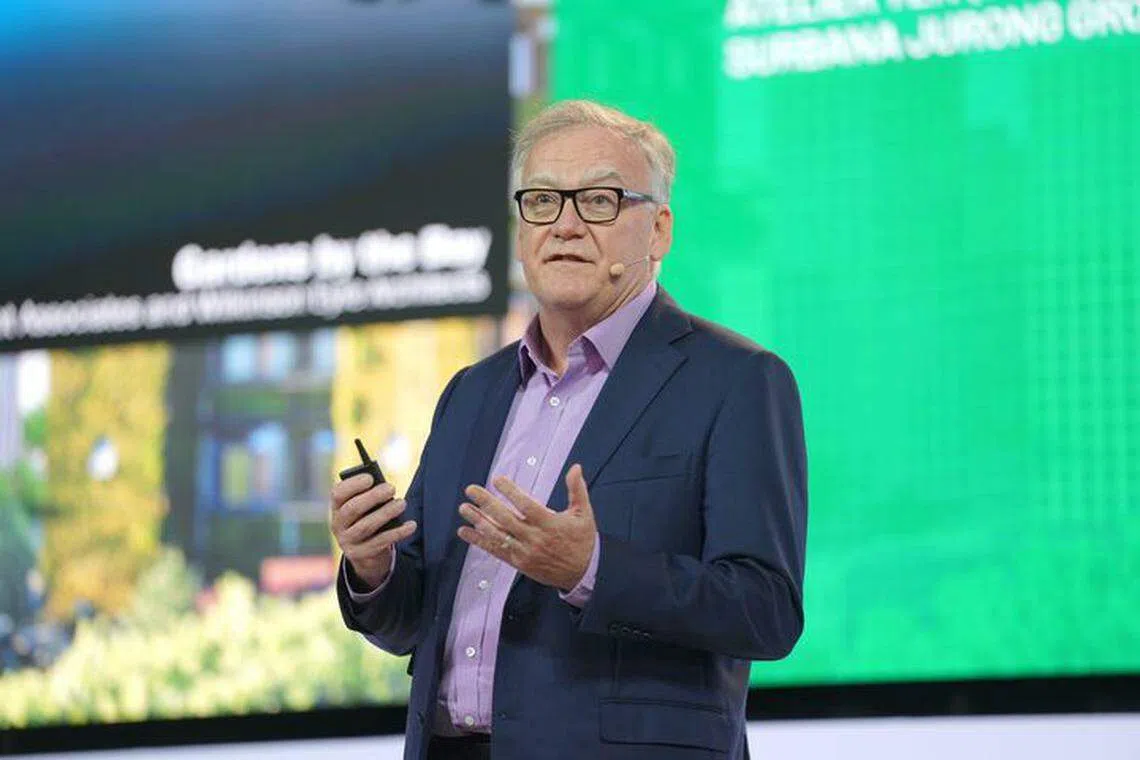Stop structural gymnastics, avoid demolishing buildings, Singapore urged

SINGAPORE loves to get its buildings to “defy gravity” or perform “structural gymnastics”, but such buildings rely on transfer structures and cantilevers that are “hugely carbon-intensive”. In a net-zero world, such designs have to go, environmental engineer Patrick Bellew said at Ecosperity Week, the flagship event of Singapore investment company Temasek.
Making the point on Wednesday (Jun 7) as he flashed an image of Marina Bay Sands, which happened to be the development he was speaking at, he said: “Not very popular in this building to talk about, but you know the cantilevers have enormous carbon implications as you try and resist all of these loads.
“Any time you see lots of concrete, and you’re defying gravity, you’re burning carbon to do it. So stop doing that, please.”
Bellew is the founding director of Atelier Ten, a London-based environmental design consultancy that joined the Temasek family in 2020 through Surbana Jurong’s majority stake acquisition.
But of all his recommendations for what has to be done for Singapore to play its part in lowering the carbon impact of the built environment sector, which currently accounts for about 40 per cent of the world’s annual emissions, the top priority has to be avoiding demolition, he stated.
“If you can avoid demolishing buildings, that big lump of carbon which is the new structure and substructure – 200 to 300 kilogrammes of carbon per square metre – is avoided straight away,” he said.
A NEWSLETTER FOR YOU

ESG Insights
An exclusive weekly report on the latest environmental, social and governance issues.

To avoid demolition, developers have to give greater consideration to the adaptive reuse potential of buildings, which entails keeping their shell or core as opposed to new build, he said.
A similar point was raised when CapitaLand Development announced in February that JCube, an 11-year-old Green Mark Platinum mall in Jurong East, will make way for a new 40-storey residential and commercial development.
Observers told The Business Times (BT) the developer could have looked into integrating JCube’s building structure into its new development through adaptive reuse, while looking into recycling some of the building’s fixtures, structures and equipment.
National University of Singapore research fellow Alvin Ee said it is generally not environmentally sustainable to tear down the whole building and rebuild it from the embodied carbon point of view. Embodied carbon refers to the greenhouse gases that are released when building materials are made, transported and assembled.
As recommended by most guiding principles, the most sustainable way is to repurpose the JCube building, Ee added. “Considering plans to make Jurong the second Central Business District of Singapore, it can be converted to offices to support such developments.”
Eugene Seah, the chief operating officer of engineering consulting group Meinhardt, said it is “always better” to consider adaptive reuse, although developers are often pressed to consider if the building’s position benefits the design and financial objective of its new asset’s objectives.
In response to BT’s queries, Chew Peet Mun, CapitaLand Development (Singapore)’s managing director of investment and development, said its decision to demolish JCube came after an extensive review with consultants found that its existing building typology is not suitable for adaptive reuse into a residential project. JCube is also not suitable for conversion to office use as it would result in suboptimal office floor plates with insufficient natural lighting, he pointed out.
Bellew on Wednesday said part of the problem is that much of the focus now is on operational carbon, the amount of carbon emitted during the operational or in-use phase of a building, or what he calls “future carbon”.
But he believes embodied carbon, or “now carbon”, will soon rear its head as a bigger issue, given that it constitutes about 80 per cent of the carbon in the first 50-year lifespan of what is considered “super green” buildings today.
Even now, he is seeing private developers change their attitude towards this, as more have moved to place a carbon tag on their assets for them to truly understand their value.
However, Bellew recognised that this is a “team problem”, with the client sitting in the middle of it. “Architects, structural engineers, landscape architects, contractors and the supply chain have got skin in the game, but investors and clients are the ones who’ve got to recognise the value in this,” he said.
Given the historically “combative relationship” among contractors, designers and clients, he also said the planning process has to be far more collaborative because decisions to drive carbon out have to be made early.
At the end of the day, decisions might converge on cost, but he argued that simplifying buildings, such as by reducing transfer structures and cantilevers, often leads to cost savings.
“If you focus on the carbon, unwittingly, you are reducing cost... It is often cheaper, not more expensive, to be a little bit more frugal,” he said.
KEYWORDS IN THIS ARTICLE
BT is now on Telegram!
For daily updates on weekdays and specially selected content for the weekend. Subscribe to t.me/BizTimes
ESG
Asia’s killer April heatwave was made much worse by climate change
Temasek-backed Climate Impact X to launch market intelligence service
With right incentives, Asia’s energy transition needs could be met by private markets
OCBC goes green with trees, tech and tie-ups
Blended finance deal value hits 5-year high of US$15 billion in 2023
Are floating cities the solution to rising seas?
